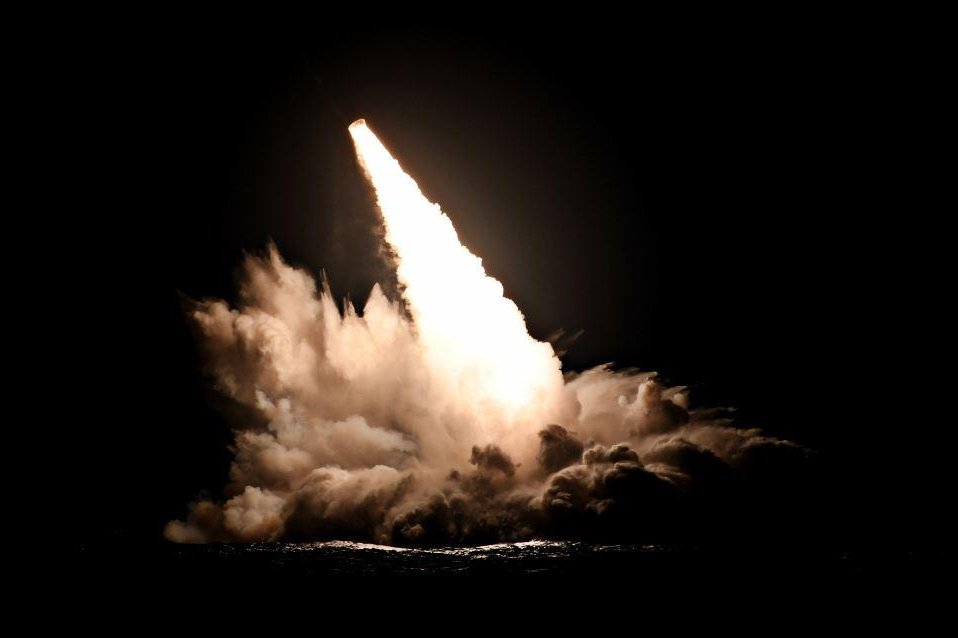Why the U.S. Air Force Wants to Combine Drones and Missiles
September 29, 2019
The future is now.
by David Axe
Key point: DARPA is a leader in its field.
The Defense Advanced Research Projects Agency — DARPA, the Pentagon’s fringe-science organization — has begun work on a small drone that extend the range of an AIM-120 air-to-air missile.
The
“Flying Missile Rail” could help U.S. Air Force and Navy fighters match and even exceed the ever-increasing range of Russian- and Chinese-made missiles. The latest AIM-120 boasts a range of around 100 miles. China
has been testing a very-long-range air-combat missile that apparently can fly as far as 200 miles.
Perhaps just as importantly, program manager Jimmy Jones — and Air Force colonel — wants the robotic launcher to be cheap and easy to produce so that the military could quickly churn out hundreds of them just in time for some big shooting war.
DARPA released its request for proposals for the Flying Missile Rail in early September 2017. The agency is proposing to spend $375,000 over the next year or so developing and testing a prototype.
The Flying Missile Rail initiative is a response to the increasing cost and complexity of new warplanes. If the military can’t build a new manned fighter quickly and cheaply, maybe it can outfit existing fighters with robotic rails in order to make the fighters deadlier in combat.
“A new advanced monolithic aircraft typically requires 10 to 25 years to design, develop and build,” Jones wrote in his notice to the aerospace industry. “New technology concepts are subject to requirements and other processes which can render them programmatically unrealizable before the technology becomes obsolete. An innovative approach is needed to ‘build on demand’ and to incrementally enhance existing capability.”
To that end, DARPA wants to do two things — develop a design for the Flying Missile Rail, while also working out a process for producing copies of the rail at a rate of 500 units per month. By comparison, the Air Force and Navy together requested just 325 AIM-120s for 2018 — meaning a production rate of around 27 missile per month.
Ideally, the Flying Missile Rail — or FMR — will be capable of doing more than just launching an AIM-120. “An FMR is a device that can optionally remain on the wing of a host F-16 or F-18 aircraft and release an AIM-120 missile, or alternately, fly away from the host aircraft acting as a booster and extending the range of an AIM-120, Small Diameter Bomb or special payload pod,” Jones wrote.
“Once the FMR reaches the target area, the FMR vehicle would be capable of loitering until the weapon is released.” DARPA hinted that industry bidders might also want to figure out how to fit two AIM-120s to a single flying rail.
The drone rail must be compatible with the existing underwing hardpoints on Air Force F-16s and Navy F/A-18s. It must also have space for a radio and antenna so that the rail can communicate with the launching fighter.
Jones stated in his notice that the FMR could share technology with the Air Force’s Loyal Wingman program, which is building plug-and-play line replaceable units — basically, boxes of radios, processors and other devices along with pre-loaded software — that can transform a manned fighter such as an F-16 into a semi-autonomous armed drone.
Loyal Wingman itself dovetails with the Air Force’s QF-16 drone target program — which modifies old F-16s for pilotless, remote flight — as well as the
Fifth-Generation Aerial Target effort, which is developing a cheap, stealthy target drone that could, in theory, possess combat capabilities.
The Air Force is also working with drone-maker Kratos on the so-called
“Low-Cost Attritable Aircraft,” of LCAA, which aims to produce a small, jet-powered armed drone that — like the Flying Missile Rail and could be manufactured quickly and cheaply. The flying branch wants to be able to buy batches of 100 LCAAs at a cost of no more than $300 million, roughly the cost of two F-35 fighters.
Finally, the Pentagon has been tinkering with an
“arsenal plane” concept that involves drones or manned fighters flying ahead of and designating targets for, heavy bombers carrying potentially scores of missiles. The drones and fighters act as nimble, flying sensors capable of surviving enemy defenses. The bombers stay out of harm’s way, waiting to fire barrages of missiles on command.
Combining all these efforts — Loyal Wingman, 5GAT, LCAA, the arsenal plane and the Flying Missile Rail — and it’s clear where U.S. air power is headed. In coming years, vast swarms of drones — some newly-built, others pilotless versions of old manned jets — could fly into combat alongside manned fighters, each drone and manned fighter carrying its own, smaller drones armed with their own missiles. All the fighters and drones would be in touch with distant arsenal planes carrying additional missile-drones.
The result could be a much more heavily-armed force capable of hitting targets at greater range, all while exposing fewer pilots to enemy fire.
And here’s the kicker — this more lethal form of air power could actually be cheaper.

